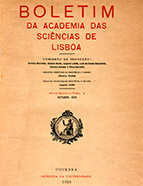

................................
This publication, in summary, serves as a rich repository of information on the interaction and coexistence of intellectuals of the highest cultural standing. It provides meticulous records of admission dates, reproductions of opinions, and documentation of individuals’ progression through various academic ranks—details largely absent from the ACL’s 18th- and 19th-century publications. This lack of documentation forced scholars of those periods to undertake significant efforts to locate and cross-reference sources (José Alberto Silva, Idem , pp. 61-67 et seq.). A similar practice was followed with the Anuário Académico [Academic Yearbook], published for the years 1932 to 1978, part of an old tradition dating back to the Lisbon Almanacks of the late 18th century, though here limited to the ACL’s context. However, there were no individual or collective projects during this period that, as in earlier centuries, guided the institution and its members toward clear, cutting-edge scientific movements, at least in the humanities and social sciences. Exceptions
included the work of António Ferrão, Avelino Teixeira da Mota, and Armando Cortesão, who used the Boletim to test and share texts they would later refine and expand into standalone volumes. By this time, the Academy had undeniably acquired an air of pomp and ceremony— a respect for protocol, a system of social and professional hierarchisation— that elevated men of arts, humanities and sciences, both living and deceased, in moments of commemoration and celebration. These factors gradually distanced the ACL from its earlier role as a centre for research and innovation, as it had been in the time of José Francisco Correia da Serra, António Caetano do Amaral, João Pedro Ribeiro, Alexandre Herculano, and their disciples and collaborators. The ACL and its Boletim became domains of consensus rather than dissent, platforms for speeches and applause rather than debates and polemics— at least, judging by the general tone of many pages of this official publication over nearly five decades.
This work is financed by national funds through FCT - Foundation for Science and Technology, I.P, in the scope of the projects UIDB/04311/2020 and UIDP/04311/2020.
